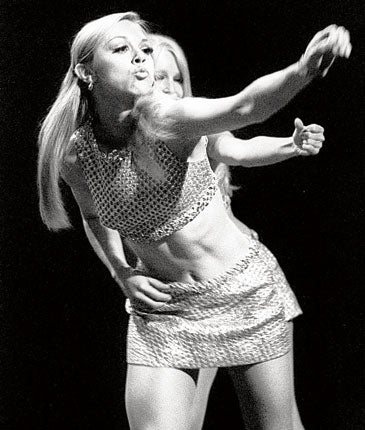Flick Colby: Dancer and choreographer whose work graced ‘Top Of The Pops’ across three decades

In the 1970s, everybody had an opinion about Pan's People, though not everybody was digging the dancing queens. Was the troupe the epitome of naffness with its ridiculous routines to classic hit records; was it an insult to modern women with its concentration on the female form; or was it just a great entertainment for adolescent lads and their still-adolescent fathers?
Who can forget Pan's People pointing at four bemused dogs as they danced to Gilbert O'Sullivan's "Get Down"? Nevertheless, their founder, Flick Colby, said, "We wanted to be the dancing equivalent of the Beatles."
The daughter of a professor of German, Felicity Colby, known as Flick, was born in March 1946 in Hazelton, Pennsylvania but raised in Clinton, New York and Andover, Maryland. She was dancing from the age of three and she studied with Robert Joffrey's Ballet Company in New York. When only 18, she choreographed a Harvard College production of the musical, Bye Bye Birdie. She worked in summer stock, singing and dancing in many musical productions.
Colby moved to Europe and became a television personality in the Netherlands. Her TV special, Felicity, was entered for Munich Television Festival and included a lengthy improvisation to Mozart. She also choreographed two operas in Belgium.
The British TV chart show Top Of The Pops started in 1964 and featured studio performances of current hits. Its quandary was that many performers, notably Elvis Presley, were not available for live performances, and the unions of the day banned filmed contributions from America. From time to time, they featured dancing to a record, sometimes featuring the Go-Jos. Colby moved to London in 1966 and she recommended a new, all-girl dance troupe to the BBC. She wanted young, attractive and experienced dancers and her first choices were Dee Dee Wilde, Babs Lord and Ruth Pearson. They came up with the name Pan's People, and in time added Andrea (Andi) Rutherford and Louise Clarke. In contrast to the often wayward rock performers, Colby insisted that they should always be always be well-organised and efficient.
When Pan's People made their début on Top Of The Pops in December 1966 they caused a sensation. Nowadays, skimpily dressed girls showing their legs can be seen in endless videos but this was highly unusual. Instead of the show dipping when a live performer couldn't appear, the ratings soared and the public wanted to know about the individual members of Pan's People.
In 1970, the England manager, Sir Alf Ramsey, told the songwriter Bill Martin to talk to the World Cup Squad about his song, "Back Home": "I told them that they would have a lot of fun making 'Back Home'," Martin says, "and I could guarantee it would beNo 1 and they would be on Top Of The Pops and get a gold record. What really attracted them was the idea of meeting Pan's People, and they told Sir Alf that they would do it."
Pan's People appeared on other programmes such as The Two Ronnies and The Bobbie Gentry Show and had their own In Concert special. Looked at on YouTube, their routines are often, well, routine, but in fairness, they frequently performed at very short notice when an artist wasn't available. They were at their best and most glamorous with straight dance records such as Van McCoy's "The Hustle", and at their worst when they had to dance along with an ill-at-ease Georgie Fame ina nightshirt singing "Seventh Son", surely the strangest production of a blues song ever shown on television. On the other hand, how could anyone create a meaningful routine for "The Smurf Song"?
Colby came out of the line-up in 1971 to concentrate on choreographing their routines, and their final Top Of The Pops appearance was in April 1976 for the Four Seasons' "Silver Star". Dee Dee Wilde established the New Pan's People, mainly as a cabaret act, and Babs Lord married the actor Robert Powell. The friendship between the dancers endured through the years, and their legacy has been to encourage a generation of young girls to take up dancing.
Colby and Pearson formed the Ruby Flipper agency and devised a mixed-sex group, also called Ruby Flipper, for Top Of The Pops. The group did not have the popularity of Pan's People and Colby was told that the British public was not ready to see black men dancing with white girls. It was replaced by another Colby and Pearson creation, Legs & Co, once again an all-girl troupe. Colby remained with Top Of The Pops until 1981, when the need for dancers had been superseded by videos.
Away from Top of the Pops, in 1970 Colby choreographed the West End hippie musical Catch My Soul, based on Othello, and 10 years later the film The Stud, starring Joan Collins. Also in 1980, she choreographed the famed Goodies episode "Saturday Night Grease", as well Basil's Christmas Cruise, although the fox's dance steps were decidedly limited. Colby also directed pop videos, notably for Duran Duran.
In 2003, Colby married George Bahlke, a professor of English at Hamilton College in Clinton, New York. She returned to Clinton, running a gift shop and commenting, "Retail is just like performing. It is about putting on a show." She was being treated forcancer at the time of her husband's death in February; she died from bronchial pneumonia.
Felicity Isabelle Colby (Flick Colby), dancer and choreographer: born Hazelton, Pennsylvania 23 March 1946; married 1967 James Ramble (marriage dissolved), 2003 George Bahlke (died 2011); died Clinton, New York 26 May 2011.
Join our commenting forum
Join thought-provoking conversations, follow other Independent readers and see their replies
Comments
Bookmark popover
Removed from bookmarks